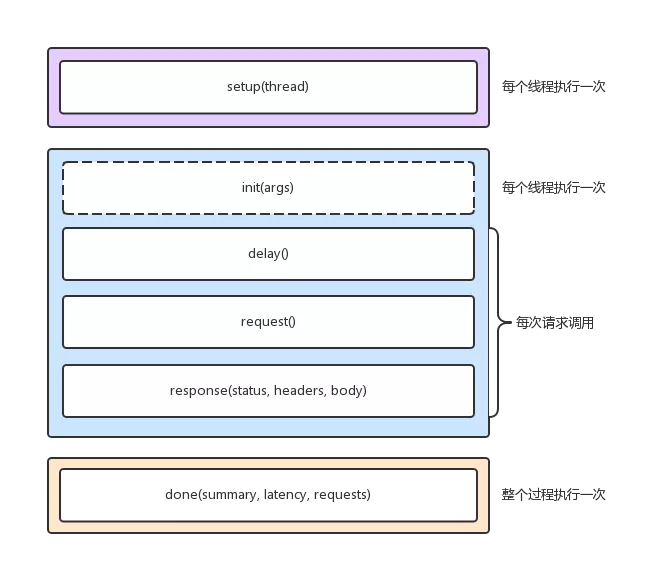0. 简要介绍
WRK 是一款轻量且易用的 HTTP 压力测试工具,通过该工具我们可以方便地对我们所开发的 WebAPI 项目进行压力测试,并且针对测试的情况返回结果。
PS:Wrk 并不能针对测试的结果生成动态的图表,如果有这种需要,可以尝试使用另一款工具 Vegeta。该项目使用的 Golang 进行编写,其 GitHub 地址为:https://github.com/tsenart/vegeta
下面的内容就是一个标准的测试结果信息:
1
2
3
4
5
6
7
8
9
10
11
|
# 针对 127.0.0.1:8080 进行压力测试
wrk -t12 -c400 -d30s http://127.0.0.1:8080/index.html
# 这里是测试结果
Running 30s test @ http://127.0.0.1:8080/index.html
12 threads and 400 connections
Thread Stats Avg Stdev Max +/- Stdev
Latency 635.91us 0.89ms 12.92ms 93.69%
Req/Sec 56.20k 8.07k 62.00k 86.54%
22464657 requests in 30.00s, 17.76GB read
Requests/sec: 748868.53
Transfer/sec: 606.33MB
|
1. 安装
关于 OS X 与 Windows 的安装可以参考 Wrk 官方 WIKI 进行操作,本文主要讲解一下 CentOS 7.x 下如果进行编译。
1
2
3
4
5
|
sudo yum groupinstall 'Development Tools'
sudo yum install -y openssl-devel git
git clone https://github.com/wg/wrk.git wrk
cd wrk
make
|
编译之后,你会得到如下结果:

可以看到生成了一个 wrk 的可执行文件,你可以将其添加到环境变量的 PATH 当中,这里就不再赘述,我们等会儿使用的时候直接 ./wrk 使用。
2. 命令说明
1
|
./wrk -H "Authorization: Bearer TokenValue" -t 2 -c 50 -d 10s --latency --timeout 1s "http://"
|
上面的命令就是一个典型的压力测试命令,关于参数的含义请看下表。
| 执行命令时的参数 |
含义 |
示例 |
| -c |
与 HTTP 保持连接的连接数,最终每个线程能够处理的为 连接数/线程数。 |
-c 50 |
| -d |
指定压力测试的时间有多长。 |
-d 10s,其他单位有 2s,2m,2h 如果不带单位的话,默认为秒。 |
| -t |
压力测试时所使用的线程数目,最好为你 CPU 核心的数量。 |
-t 4 |
| -s |
指定要执行的 Lua 脚本 |
-s ./post.lua |
| -H |
执行请求的时候所附带的 Header 组。 |
-H “User-Agent: wrk” |
| –latency |
打印详细的统计信息。 |
–latency |
| –timeout |
每次请求所返回响应体的时间,如果超过了配置的时间,则视为请求超时。 |
–timeout 1s |
3. 开始压力测试

执行了上述代码之后我们可以看到很直观的信息,第一个就是 20s 的时间内完成了 2887 次请求,一共接受到了 2.46MB 的数据。在 Socket errors 里面我们可以看到有 35 个请求产生了超时的情况,每秒执行的请求大概为 144.20 个,每秒的数据传输大概为 125.75 KB。
除此之外,还说明了平均每次请求所消耗的时间为 338.44 ms,最极端的情况为 994.27ms。
4. LUA 脚本
在第三节我们可以看到一些标准的 GET 请求我们可以直接通过指定命令来进行测试,即便该接口有授权验证,我们可以通过 -H 参数来指定 Authorization 头来实现权限验证。
但是针对一些复杂的情况,我们就需要编写 LUA 脚本来实现压力测试了。
官方编写了很多的 LUA 脚本 DEMO ,存放在 GitHub 上面,其地址为:https://github.com/wg/wrk/tree/master/scripts。
这里我们以实现 POST 请求为例:
1
2
3
|
wrk.method = "POST"
wrk.body = '{"username":"admin","password":"123qwe","rememberClient":true}'
wrk.headers["Content-Type"] = "application/json"
|
这里我们的接口地址更改了一下,改变成了 Login 接口,该接口需要传入用户名与密码,并且其 Method 为 POST。
将上述 LUA 脚本保存为 post.lua 文件,然后通过 -s 参数指定 LUA 脚本的路径并执行。

5. LUA 脚本相关详解
WRK 中执行 HTTP 请求的时候,调用 Lua 分为 3 个阶段,setup、running、done,每个 WRK 线程中都有独立的脚本环境。

5.1 WRK 的全局属性
1
2
3
4
5
6
7
8
9
10
|
wrk = {
scheme = "http",
host = "localhost",
port = nil,
method = "GET",
path = "/",
headers = {},
body = nil,
thread = <userdata>,
}
|
5.2 WRK 的全局方法
1
2
3
4
5
6
7
8
9
10
|
-- 生成整个request的string,例如:返回
-- GET / HTTP/1.1
-- Host: tool.lu
function wrk.format(method, path, headers, body)
-- 获取域名的IP和端口,返回table,例如:返回 `{127.0.0.1:80}`
function wrk.lookup(host, service)
-- 判断addr是否能连接,例如:`127.0.0.1:80`,返回 true 或 false
function wrk.connect(addr)
|
5.3 Setup 阶段
setup() 方法是在线程创建之后,启动之前。
1
2
3
4
5
6
7
|
function setup(thread)
-- thread提供了1个属性,3个方法
-- thread.addr 设置请求需要打到的ip
-- thread:get(name) 获取线程全局变量
-- thread:set(name, value) 设置线程全局变量
-- thread:stop() 终止线程
|
5.4 Running 阶段
1
2
3
4
5
6
7
8
9
10
11
|
function init(args)
-- 每个线程仅调用1次,args 用于获取命令行中传入的参数, 例如 --env=pre
function delay()
-- 每个线程调用多次,发送下一个请求之前的延迟, 单位为ms
function request()
-- 每个线程调用多次,返回http请求
function response(status, headers, body)
-- 每个线程调用多次,返回http响应
|
5.5 Done 阶段
可以用于自定义结果报表,整个过程中只执行一次。
1
2
3
4
5
6
7
8
9
10
11
12
13
14
15
16
17
18
19
20
21
22
|
function done(summary, latency, requests)
latency.min -- minimum value seen
latency.max -- maximum value seen
latency.mean -- average value seen
latency.stdev -- standard deviation
latency:percentile(99.0) -- 99th percentile value
latency(i) -- raw value and count
summary = {
duration = N, -- run duration in microseconds
requests = N, -- total completed requests
bytes = N, -- total bytes received
errors = {
connect = N, -- total socket connection errors
read = N, -- total socket read errors
write = N, -- total socket write errors
status = N, -- total HTTP status codes > 399
timeout = N -- total request timeouts
}
}
|
而官方的 setup.lua 脚本则是重载这些方法并使用的一个 DEMO:
1
2
3
4
5
6
7
8
9
10
11
12
13
14
15
16
17
18
19
20
21
22
23
24
25
26
27
28
29
30
31
32
33
34
35
36
37
38
|
-- example script that demonstrates use of setup() to pass
-- data to and from the threads
local counter = 1
local threads = {}
function setup(thread)
thread:set("id", counter)
table.insert(threads, thread)
counter = counter + 1
end
function init(args)
requests = 0
responses = 0
local msg = "thread %d created"
print(msg:format(id))
end
function request()
requests = requests + 1
return wrk.request()
end
function response(status, headers, body)
responses = responses + 1
end
function done(summary, latency, requests)
for index, thread in ipairs(threads) do
local id = thread:get("id")
local requests = thread:get("requests")
local responses = thread:get("responses")
local msg = "thread %d made %d requests and got %d responses"
print(msg:format(id, requests, responses))
end
end
|
6. 参考资料
wrk中的lua脚本:https://type.so/linux/lua-script-in-wrk.html
http 性能测试 wrk使用教程:https://juejin.im/post/5a59e74f5188257353008fea



